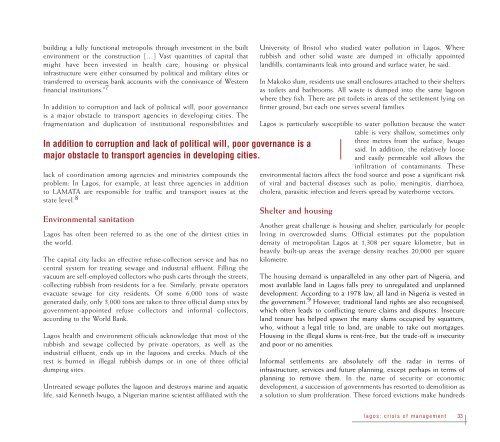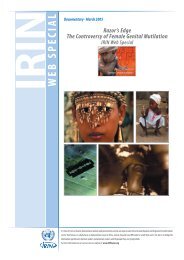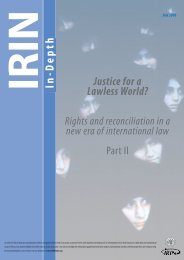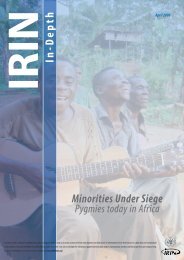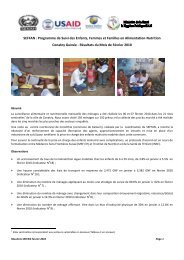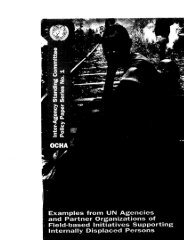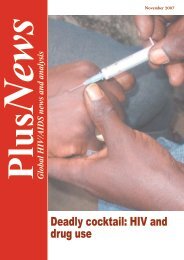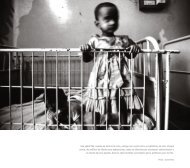Buses drive through crowded Oshodi market. Lagos is ... - IRIN
Buses drive through crowded Oshodi market. Lagos is ... - IRIN
Buses drive through crowded Oshodi market. Lagos is ... - IRIN
You also want an ePaper? Increase the reach of your titles
YUMPU automatically turns print PDFs into web optimized ePapers that Google loves.
uilding a fully functional metropol<strong>is</strong> <strong>through</strong> investment in the built<br />
environment or the construction […] Vast quantities of capital that<br />
might have been invested in health care, housing or physical<br />
infrastructure were either consumed by political and military elites or<br />
transferred to overseas bank accounts with the connivance of Western<br />
financial institutions.” 7<br />
In addition to corruption and lack of political will, poor governance<br />
<strong>is</strong> a major obstacle to transport agencies in developing cities. The<br />
fragmentation and duplication of institutional responsibilities and<br />
In addition to corruption and lack of political will, poor governance <strong>is</strong> a<br />
major obstacle to transport agencies in developing cities.<br />
lack of coordination among agencies and min<strong>is</strong>tries compounds the<br />
problem: In <strong>Lagos</strong>, for example, at least three agencies in addition<br />
to LAMATA are responsible for traffic and transport <strong>is</strong>sues at the<br />
state level. 8<br />
Environmental sanitation<br />
<strong>Lagos</strong> has often been referred to as the one of the dirtiest cities in<br />
the world.<br />
The capital city lacks an effective refuse-collection service and has no<br />
central system for treating sewage and industrial effluent. Filling the<br />
vacuum are self-employed collectors who push carts <strong>through</strong> the streets,<br />
collecting rubb<strong>is</strong>h from residents for a fee. Similarly, private operators<br />
evacuate sewage for city residents. Of some 6,000 tons of waste<br />
generated daily, only 3,000 tons are taken to three official dump sites by<br />
government-appointed refuse collectors and informal collectors,<br />
according to the World Bank.<br />
<strong>Lagos</strong> health and environment officials acknowledge that most of the<br />
rubb<strong>is</strong>h and sewage collected by private operators, as well as the<br />
industrial effluent, ends up in the lagoons and creeks. Much of the<br />
rest <strong>is</strong> burned in illegal rubb<strong>is</strong>h dumps or in one of three official<br />
dumping sites.<br />
Untreated sewage pollutes the lagoon and destroys marine and aquatic<br />
life, said Kenneth Iwugo, a Nigerian marine scient<strong>is</strong>t affiliated with the<br />
University of Br<strong>is</strong>tol who studied water pollution in <strong>Lagos</strong>. Where<br />
rubb<strong>is</strong>h and other solid waste are dumped in officially appointed<br />
landfills, contaminants leak into ground and surface water, he said.<br />
In Makoko slum, residents use small enclosures attached to their shelters<br />
as toilets and bathrooms. All waste <strong>is</strong> dumped into the same lagoon<br />
where they f<strong>is</strong>h. There are pit toilets in areas of the settlement lying on<br />
firmer ground, but each one serves several families.<br />
<strong>Lagos</strong> <strong>is</strong> particularly susceptible to water pollution because the water<br />
table <strong>is</strong> very shallow, sometimes only<br />
three metres from the surface, Iwugo<br />
said. In addition, the relatively loose<br />
and easily permeable soil allows the<br />
infiltration of contaminants. These<br />
environmental factors affect the food source and pose a significant r<strong>is</strong>k<br />
of viral and bacterial d<strong>is</strong>eases such as polio, meningit<strong>is</strong>, diarrhoea,<br />
cholera, parasitic infection and fevers spread by waterborne vectors.<br />
Shelter and housing<br />
Another great challenge <strong>is</strong> housing and shelter, particularly for people<br />
living in over<strong>crowded</strong> slums. Official estimates put the population<br />
density of metropolitan <strong>Lagos</strong> at 1,308 per square kilometre, but in<br />
heavily built-up areas the average density reaches 20,000 per square<br />
kilometre.<br />
The housing demand <strong>is</strong> unparalleled in any other part of Nigeria, and<br />
most available land in <strong>Lagos</strong> falls prey to unregulated and unplanned<br />
development. According to a 1978 law, all land in Nigeria <strong>is</strong> vested in<br />
the government. 9 However, traditional land rights are also recogn<strong>is</strong>ed,<br />
which often leads to conflicting tenure claims and d<strong>is</strong>putes. Insecure<br />
land tenure has helped spawn the many slums occupied by squatters,<br />
who, without a legal title to land, are unable to take out mortgages.<br />
Housing in the illegal slums <strong>is</strong> rent-free, but the trade-off <strong>is</strong> insecurity<br />
and poor or no amenities.<br />
Informal settlements are absolutely off the radar in terms of<br />
infrastructure, services and future planning, except perhaps in terms of<br />
planning to remove them. In the name of security or economic<br />
development, a succession of governments has resorted to demolition as<br />
a solution to slum proliferation. These forced evictions make hundreds<br />
l a g o s : c r i s i s o f m a n a g e m e n t 33


